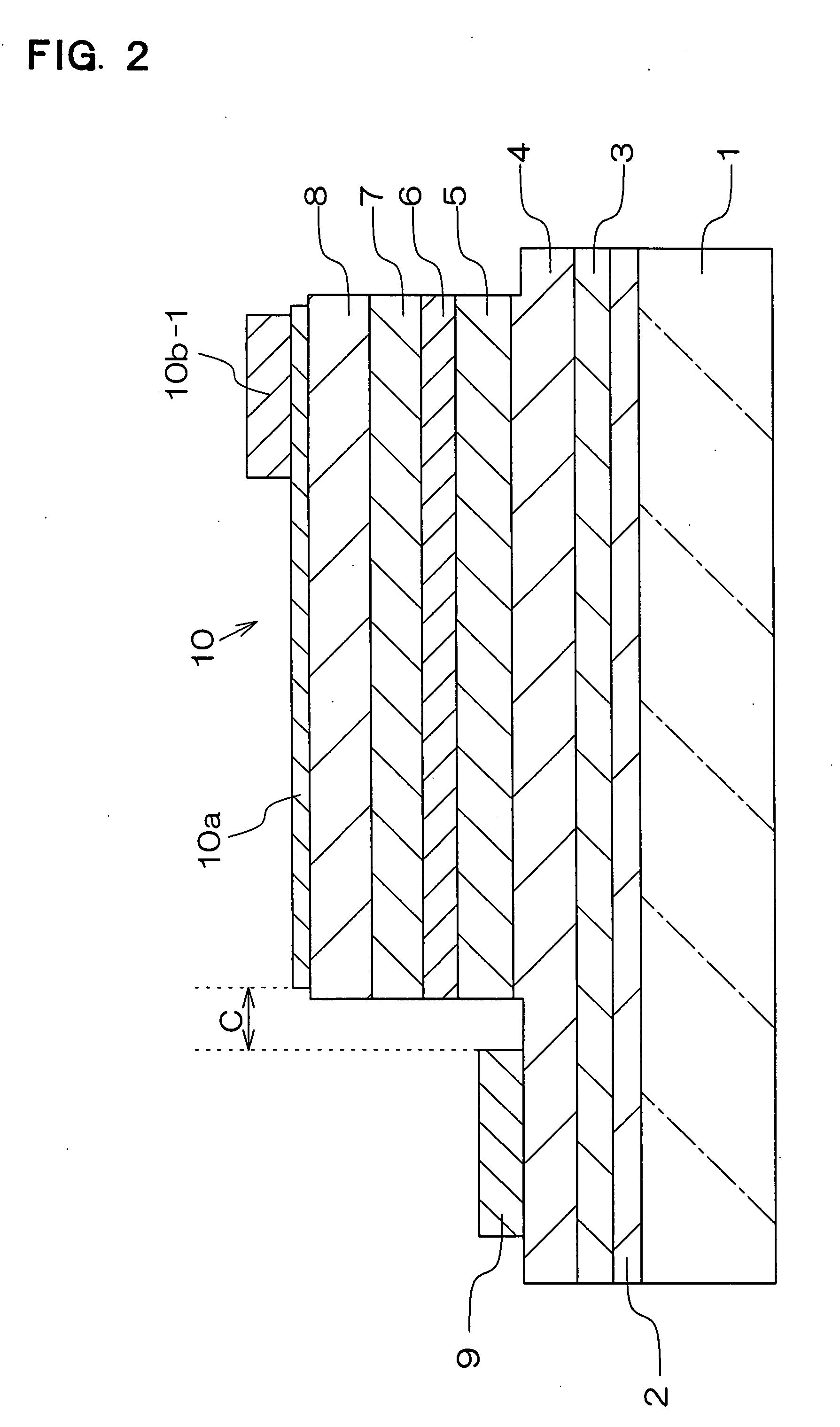Light-emitting diode
a technology of light-emitting diodes and diodes, which is applied in the direction of basic electric elements, electrical equipment, semiconductor devices, etc., can solve the problems of insufficient light-emission efficiency, insufficient concentration current area, and difficult to make light-emission wide and uniform in an led
- Summary
- Abstract
- Description
- Claims
- Application Information
AI Technical Summary
Benefits of technology
Problems solved by technology
Method used
Image
Examples
embodiment 1
[0044] The following description will describe an LED of the embodiment 1 with reference to FIG. 1 and FIG. 2. As shown in these drawings, the LED of this embodiment has a p-side electrode and an n-side electrode positioned in the same plane side. FIG. 1 is a schematic diagram showing the LED of this embodiment in view from an electrode-forming-plane side. FIG. 2 is a cross-sectional view schematically showing layer construction of the LED of this embodiment of FIG. 1 taken along the line II-II.
[0045] As shown in FIG. 1, the LED of the embodiment 1 according to the present invention has a shape with a longitudinal direction, which is a predetermined direction, in the view from the electrode-forming-plane side. In this embodiment, the shape is a rectangle, in which one pair of sides is longer than another pair of sides. An n-side connecting portion 9-1 is positioned in proximity to one end in the longitudinal direction of the rectangle. A p-side connecting portion 10b-1 is positioned...
embodiment 2
[0072] The following description will describe an LED of the embodiment 2 with reference to FIG. 3 and FIG. 4. FIG. 3 is a schematic diagram showing the LED of this embodiment in view from an electrode-forming-plane side. FIG. 4 is a cross-sectional view schematically showing layer construction of the LED of this embodiment of FIG. 3 taken along the line IV-IV. In addition, the same reference signs show the members of similar function in the embodiment 1.
[0073] The LED of this embodiment has the same construction mentioned as the LED of the embodiment 1 except that the p-side current diffusing member 10a has a plurality of openings 10aa. In addition, the p-side pad member does not have the p-side extending portion. In this case, the p-side extending portion does not cut off the light emitted from the active layer. Such a construction is preferable in view of light outgoing. Needless to say, the LED can also have the p-side extending portion in view of current diffusing. A designer c...
embodiment 3
[0081] The following description will describe an LED of the embodiment 3 with reference to FIG. 5 and FIG. 6. In addition, the same reference signs show the members of similar function in the embodiment 1. The LED of this embodiment has the same construction mentioned as the LED of the embodiment 1 except the members described bellow.
[0082] In the LED of this embodiment, as mentioned above, the p-side current diffusing member 10a is formed also in the n-side connecting area. The n-side pad member 9-1 and the p-side pad member 10b-1 are positioned at opposite corners of the LED with a rectangular shape in view from the electrode-forming-plane side. In addition, the n-side extending portion 9-2 and the p-side extending portion 10b-2 are partially opposed to each other. Additionally, a plurality of bumps 11, which improves light outgoing, are provided in the area, in which the n-type contact portion 4 is exposed in order to form the n-side electrode, so as to surround the laminated-la...
PUM
 Login to View More
Login to View More Abstract
Description
Claims
Application Information
 Login to View More
Login to View More - R&D
- Intellectual Property
- Life Sciences
- Materials
- Tech Scout
- Unparalleled Data Quality
- Higher Quality Content
- 60% Fewer Hallucinations
Browse by: Latest US Patents, China's latest patents, Technical Efficacy Thesaurus, Application Domain, Technology Topic, Popular Technical Reports.
© 2025 PatSnap. All rights reserved.Legal|Privacy policy|Modern Slavery Act Transparency Statement|Sitemap|About US| Contact US: help@patsnap.com



